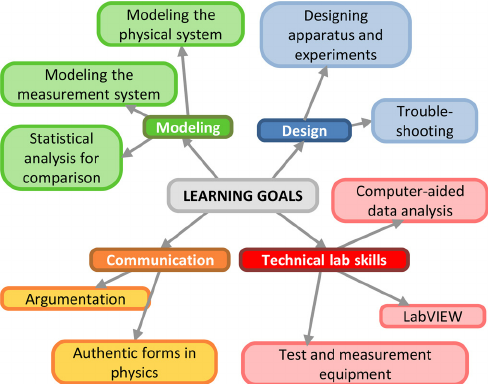PHYS 3701 (from J. Roche)
- Plan experiments taking into account the type and amount and accuracy of date needed to give reproducible and accurate results.
- Make most common types of ( modified from several different types of common) laboratory measurements including for example small signal measurements and resonance measurements.
- Use a computer to make plots and tables, do curve-fitting, do basic statistical analysis proficiently and relate the fit parameters to physical quantities.
- Identify the claims, theoretical background, experimental evidence, and logical connections that hold their own argument together.
- Communicate results ethically and effectively in the oral form
typical for Physics and Astronomy presentations.
PHYS3702 (from P. King)
- Construct arguments and identify trends based on experimentally controlled observations.
- Discuss the instrumentation used in an experimental investigation, including any systematic errors or biases that might be introduced by these
- Work together in small groups to design and construct experiments.
- Maintain laboratory notebooks of sufficient quality for beginning graduate-level research
- Use a computer to do sophisticated data analysis, including uncertainty analysis using professional
standards.
- Use theoretical models to predict and understand measurement results
- Make written scientific arguments using the typical elements of
thecnical communciation for Physics presentations (modified from a number of standard elements of technical communication)
ASTR4271 (from R. Chornock)
- calculate and predict signal-to-noise ratio for CCD
observations of astronomical sources.
- calibrate astronomical measurements from detector output
to physical units.
- Demonstrate familiarity with optical photometric systems and their
definitions.
- Describe the basics of CCD design and operation.
- Illustrate the essential elements of writing successful observing
proposals.
- Express the results of a scientific project in both written and
oral formats
Learning outcomes suggested by AAPT
- Constructing knowledge: collect, analyze, and interpret real data from personal
observations of the physical world to develop a physical worldview.
- Modeling: develop abstract representations of real systems studied in the laboratory,
understand their limitations and uncertainties, and make predictions using models.
- Designing Experiments: develop, engineer, and troubleshoot experiments to test models and
hypotheses within specific constraints such as cost, time, safety, and available equipment.
- Developing technical and practical laboratory skills: become proficient using common test equipment in a range of standard laboratory measurements while being cognizant of
device limitations.
- Analyzing and visualizing data: analyze and display data using statistical methods and
critically interpret the validity and limitations of these data and their uncertainties.
- Communicating Physics: present results and ideas with reasoned arguments supported by
experimental evidence and utilizing appropriate and authentic written
and verbal forms.
Last modified: Fri Mar 6 16:32:18 EST 2020

